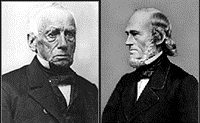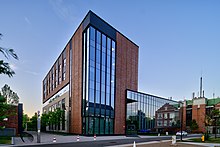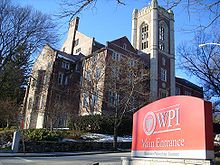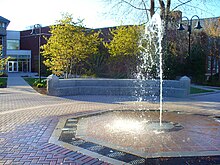User:سائغ/sandbox3
Worcester Polytechnic Institute (WPI) is a private research university in Worcester, Massachusetts, that concentrates on instruction in and research into technical arts and applied sciences.[1]
Founded in 1865 in Worcester, WPI was one of the United States' first engineering and technology universities and now has 14 academic departments with over 50 undergraduate and graduate degree programs in science, engineering, technology, management, the social sciences, and the humanities and arts, leading to bachelor's, master's and PhD degrees. WPI's faculty works with students in a number of research areas, including biotechnology, fuel cells, information security, surface metrology, materials processing, and nanotechnology. It is classified among "R2: Doctoral Universities – High research activity".[2]
History[edit]
Worcester Polytechnic Institute was founded by self-made tinware manufacturer, John Boynton, and Ichabod Washburn, owner of the world's largest wire mill. Boynton envisioned science schooling that would elevate the social position of the mechanic and manufacturer, but not necessarily teach the skills needed to become either. Washburn, on the other hand, wanted to teach technical skills through a sophisticated apprenticeship approach. Boynton consulted Seth Sweetser, a pastor, for ways to realize his vision. By chance it happened that Ichabod Washburn had previously consulted Sweetser about the proper way to actualize his own vision.[3]

Washburn was disappointed to learn of Boynton's offer to create a college, although Washburn claimed, "I prefer to be imposed upon by others rather than by myself in withholding where I ought to give," with the help of Sweetser's diplomacy and wisdom, he agreed to build, furnish, and endow a "Department of Practical Mechanics" at Boynton's school. He specified, however, that every student should blend theory learned in the classroom with practice in the shops.[3]
Sweetser drafted a letter expressing Boynton's and Washburn's wish to other significant men within Worcester County. The document was sent to 30 Worcester businessmen. It told of a "liberal proposal to found a Free School for Industrial Science" in Worcester and called for a meeting later in the month. After that meeting the following notice appeared in the Worcester Palladium: "A Gentleman, who for the present withholds his name from the public, offers a fund of $100,000 for the establishment of a scientific school in Worcester, upon the condition that our citizens shall furnish the necessary land and buildings." Further funding and land grants for the university were given by Stephen Salisbury II, who was an influential merchant and later served as the first president of the Institute's board of directors.[4]
In response to this anonymous request, more than 225 Worcester citizens and the workers at 20 of the city's factories and machine shops contributed to the construction of the original building. On May 10, 1865, after House and Senate approval, the secretary of the commonwealth recorded the Institute as a legal corporation, and it came into formal existence.[3]

Both Boynton and Washburn died before the opening of the college on November 11, 1868. On that day, Charles O. Thompson, the first president of the Institute stood before WPI's first two buildings named Boynton Hall and Washburn Shops in honor of their respective donors, with their distinctive towers that even then symbolized the institution's two educational objectives of theory and practice, and inaugurated the Worcester County Free Institute of Industrial Science.[5][6]

WPI was led in its early years by president and professor of chemistry Charles O. Thompson.[7] Early graduates of WPI went on to become mechanical and civil engineers, as well as artisans, bankers, and enter other prominent occupations. WPI continuously expanded its campus and programs throughout the early twentieth century, eventually including graduate studies and a program in electrical engineering. During World War II, WPI offered defense engineering courses and was selected as one of the colleges to direct the V-12 Navy College Training Program.[8]
During this time, WPI suffered from the lack of a unified library system, well-maintained buildings, and national recognition. This changed under the leadership of president Harry P. Storke from 1962 to 1969. Building on growth under Arthur Bronwell's presidency, Storke brought significant change to the school in what would be known as the WPI Plan. The Plan called for the creation of three projects and drastically redesigned the curriculum to address how a student learns. The Storke administration also launched a capital campaign that resulted in the creation of the George C. Gordon Library, added residence halls, an auditorium, and a modern chemistry building. Furthermore, women were first allowed to enter WPI in February 1968.[9] The WPI Plan is the guiding principle behind undergraduate education at the Institute today, and is arguably the most notable contribution WPI has made towards science and engineering education. In 2016, the National Academy of Engineering awarded their prestigious Bernard M. Gordon Prize for Innovation in Engineering and Technology Innovation to WPI, recognizing the Institute's groundbreaking approach to engineering education.[10]
Today, WPI is primarily an undergraduate-focused institution, though expansion of graduate and research programs is a long-term goal. The WPI Bioengineering Institute is a significant contributor to Worcester's growing biotechnology industry. Significant research in other fields such as robotics, metallurgy, untethered health care, fuel cells, the learning sciences, applied mathematics and fire protection currently help to maintain WPI's position as an important, specialized research university.
Campus[edit]



Set in an urban context in New England's second largest city,[11] WPI's main campus is entirely privately owned, ungated, and uninterrupted by public roads. The campus sits on Boynton Hill, apart from the adjacent neighborhood, which includes restaurants and stores on Highland Street.
Once a laboratory for electromagnetic research, the "Skull Tomb" was built entirely without ferrous metals. Several years after its construction, electrified trolley tracks were built in Worcester which led to the building's disuse. It served for a time as a site for Robert Goddard's rocket fuel research as the building is relatively isolated from other buildings on campus and Dr. Goddard's research had previously led to explosions on campus. Subsequent to the building earning its present nickname, "Skull", a secret honor society, inherited the building. The building was reconditioned in 2004.
The 'Two Towers' shown in old WPI logos show the clock tower of Boynton Hall and the arm and hammer weathervane of the Washburn Shops. The original weathervane was stolen in October 1975 and never recovered. Boynton and Washburn were the university's first buildings, housing the classrooms and laboratories, respectively. The Two Towers symbolize Theory and Practice, which are the foundation of the university and still the approach used today. Boynton was completed in 1868 and Washburn followed shortly after that same year.[12][13]

WPI's school colors, Crimson and Gray, were inspired by the natural pigmentation of the beech tree next to the bush sitting near the entrance of Boynton Hill. The tree was planted in 1945 and presently stands at over 60 feet tall.[14]
Near the edge of the WPI campus is a large Tudor-style mansion built in 1923 by WPI alumnus Aldus Chapin Higgins and later bequeathed to his alma mater. Named appropriately as the Higgins House, the mansion and the surrounding English garden serves as the backdrop for many alumni events and is the headquarters for the Office of Alumni Relations.[15]
WPI had one of 35 civilian research nuclear reactors licensed to operate in the United States. It was built and used in research during the height of the Cold War but the school's nuclear program ended at the turn of the century. The reactor was decommissioned and filled-in early in 2018 due to heightened security around reactors post-9/11 and lack of need.[16]
A large bronze statue of Gompei the Goat stands at the quad side of the Bartlett Center, WPI's admission building. Gompei was an actual goat given as a gift by the class of 1891 and eventually became the school's official mascot. It was named after the first elected goat keeper, Gompei Kuwada. The original bronze goat head is located in the Skull Tomb, on a shelf with carved rocks and empty liquor bottles.[17]

The Foisie Innovation Studio and Messenger Hall, a $49 million, 78,000-square-foot residential and classroom facility was dedicated in 2018. The Foisie Innovation Studio, designed by Gensler, contains a robotics lab, a makerspace, and high-tech classrooms. Messenger Hall is a residence hall with 140 beds and tech suites.[18]
Academics[edit]



WPI offers a variety of majors in engineering, science, management, liberal arts, and social science at the undergraduate and graduate level. It is most well-known for its engineering disciplines and is one of the top-ranked schools to attend for engineering in North America and the world over. Unlike many peer universities, WPI does not combine related departments into colleges or schools.
WPI's undergrad schedule is also unusual compared to most universities. Instead of a normal semester, WPI has 7-week terms, labeled A through D, with optional E Terms 1 and 2 in the summer. It is normal to take three courses during each term, which allows students to complete a year's worth of Chemistry, Physics, Mathematics, etc. in only one semester. This faster pace allows for students to take more courses to substantiate their diploma. The graduate student calendar follows a conventional two semester schedule.
WPI's student performance evaluation system uses grades A, B, or C. If a student were to not satisfactorily complete the course or elect to drop the course, they would receive a No Record (NR). The NR designation is used since there is no differentiation between a dropped course or an unsuccessful attempt to complete it.
WPI Corporate and Professional Education (CPE) also offers academic opportunities to individuals and companies. Programs can be offered online, onsite, on campus, or in a blended format. CPE has graduate programs, online degrees and professional development workshops. Among its recent program additions, CPE launched the first online Graduate Certificate in Program Protection Planning, and a new Graduate Certificate focused on Cyber Security for Power Systems.
Project-based learning system[edit]
WPI's curriculum is focused on project-based learning, an emphasis established in 1970 as part of what was called the WPI Plan.[19] This allows for a student to learn theory and practices concurrently. This approach includes an Interactive Qualifying Project (IQP) to study the social effects of technology collaboratively with students from other disciplines and a Major Qualifying Project (MQP) that falls within the student's discipline, though they were introduced in the last 40 years. Usually the IQP, and MQP are completed in the junior and senior years, respectively. The MQP is similar to other schools' "senior thesis," while the IQP is a bit more unique.
Global Projects Program[edit]
At WPI, the opportunity to complete significant project work off campus is an integral element of an academic program that emphasizes the practical application of knowledge to meaningful technical and societal problems. As of the class of 2022, all first-year students receive a global project scholarship of up to $5,000 for this work. Through the Global Projects Program, over 60% of WPI students complete at least one of their required projects at an off-campus Project Center. Typically, students work under faculty guidance in small teams at Project Centers to address problems posed by external agencies and organizations.
Through the Global Projects Program, WPI sends more engineering students abroad than any US college or university. As of the 2019-2020 academic year, the program included established over 50 Project Centers spanning 6 continents.[20] Between 1974, when the first WPI Project Center was established in Washington, DC, and 2014, over 7,000 students had completed over 2,000 projects in locations around the globe.
The Global Projects Program was cited by the Association of American Colleges and Universities in 2000, when it named WPI one of its 16 Greater Expectations Leadership Institutions to serve as models for the future of undergraduate education in the United States.


Interactive Qualifying Project[edit]
The Interactive Qualifying Project (IQP) is described as a "project which relates technology and science to society or human needs."[21] This project is very broad in scope, encompassing a wide variety of topics and actions. Generally, IQPs are designed to solve a societal problem using technology. This can range from improving high school science education to redesigning an irrigation system in Thailand. This project is often done off-campus through WPI's Global Projects Program. From an educational perspective, the IQP serves to emphasize team-based work and introduces a real-world responsibility absent from courses. Many IQPs have made a significant impact on the community in which they are done.
Major Qualifying Project[edit]
The Major Qualifying Project (MQP) assesses knowledge in a student's field of study. As mentioned above, this project is similar to a senior thesis, with students doing independent research or design. MQPs are often funded by either WPI or external corporations. Topics of MQPs done in the recent past include the design of the MIR 2 space station life support system module, a study of the effects of stress and nicotine on ADHD, the design of a research rocket, a mathematical viscoelastic cell motility model, experimental research of liquid crystals using atomic force microscopy, and the design of polymers for medicine delivery.[22]
General Requirements
To create a rounded experience, students are also required to fulfill a Humanities and Arts requirement as well as a Social Science & Policy Studies requirement. These are intended to give width, breadth, and context to an engineering degree.
Rankings and reputation[edit]
| Academic rankings | |
|---|---|
| National | |
| ARWU[23] | 191-206 |
| Forbes[24] | 93 |
| U.S. News & World Report[25] | 66 |
| Washington Monthly[26] | 99 |
| WSJ / College Pulse[27] | 120 |
| Global | |
| ARWU[28] | 901-1000 |
| QS[29] | 701-750 |
| THE[30] | 601-800 |
| U.S. News & World Report[31] | 1131 |
WPI was ranked tied for 66th among national universities in U.S. News & World Report's 2021 review of "Best Colleges" in the U.S. U.S. News & World Report also rated it tied at 42nd for "Most Innovative", 67th for "Best Value", and 265th for "Top Performers on Social Mobility" among national universities.[32]
In 2013, Businessweek ranked Worcester Polytechnic Institute (WPI) No. 1 in the nation for its part-time Master of Business Administration (MBA) program, and No. 1 in the nation for student satisfaction in the program.[33]
In August 2019, Forbes magazine's annual ranking of "America's Top Colleges" placed WPI at No. 93. "Forbes’ college ranking is distinguished by its consumer-centric approach," said Caroline Howard, Director of Editorial Operations, Forbes. "The evaluation of the 650 undergraduate institutions is based exclusively on the quality of the education they provide, the experiences of the students and their post-graduate success and financial well-being."[34]
- ^ "Points of Distinction". Admissions & Outreach Office at Cal Poly Pomona. Archived from the original on August 21, 2012. Retrieved September 20, 2012.
- ^ "Carnegie Classifications Institution Lookup". carnegieclassifications.iu.edu. Center for Postsecondary Education. Retrieved September 13, 2020.
- ^ a b c [1] URL accessed on July 8, 2012
- ^ WPI's Founding Fathers: Stephen Salisbury II Archived September 1, 2006, at the Wayback Machine Retrieved July 23, 2006
- ^ WPI's Founding Fathers: John Boynton Archived September 1, 2006, at the Wayback Machine Retrieved July 23, 2006
- ^ WPI's Founding Fathers: Ichabod Washburn Archived September 1, 2006, at the Wayback Machine Retrieved July 23, 2006
- ^ Two Towers: The Story of Worcester Tech 1865–1965 Archived September 5, 2006, at the Wayback Machine Retrieved July 23, 2006
- ^ Two Towers: The Story of Worcester Tech 1865–1965 Archived September 27, 2011, at the Wayback Machine Retrieved July 23, 2006
- ^ The Miracle at Worcester: The Story of the WPI Plan Archived September 8, 2006, at the Wayback Machine Retrieved July 23, 2006
- ^ The National Academy of Engineering Recognizes WPI Retrieved October 3, 2018
- ^ STAFF, John J. Monahan TELEGRAM & GAZETTE. "Challenge boosts two cities' populations". telegram.com.
- ^ "WPI George C. Gordon Library – The Two Towers Tradition". Archived from the original on February 17, 2005. Retrieved October 24, 2005.
- ^ a b "About WPI". WPI.
- ^ Worcester Polytechnic Institute Self-Guided Tour [2] Archived January 20, 2013, at the Wayback Machine, Retrieved on May 3, 2012
- ^ WPI Alumni Office [3], Retrieved on June 6, 2012
- ^ coldwar-ma [4], Retrieved on December 11, 2012
- ^ Goat's Head [5], Retrieved on July 1, 2012
- ^ Duffy, Alison (September 14, 2018). "WPI Opens the Foisie Innovation Studio and Messenger Hall". Worcester Polytechnic Institute. Retrieved August 2, 2020.
- ^ "The WPI Plan". WPI. Retrieved September 16, 2019.
- ^ "Project Center Directory". WPI. Retrieved September 16, 2019.
- ^ WPI Projects Program Retrieved July 28, 2006
- ^ WPI Project Presentation Day 2006, Retrieved July 28, 2006.
- ^ "ShanghaiRanking's 2023 Academic Ranking of World Universities". Shanghai Ranking Consultancy. Retrieved February 10, 2024.
- ^ "Forbes America's Top Colleges List 2023". Forbes. Retrieved September 22, 2023.
- ^ "2023-2024 Best National Universities". U.S. News & World Report. Retrieved September 22, 2023.
- ^ "2023 National University Rankings". Washington Monthly. Retrieved February 10, 2024.
- ^ "2024 Best Colleges in the U.S." The Wall Street Journal/College Pulse. Retrieved January 27, 2024.
- ^ "ShanghaiRanking's 2023 Academic Ranking of World Universities". Shanghai Ranking Consultancy. Retrieved February 10, 2024.
- ^ "QS World University Rankings 2024: Top global universities". Quacquarelli Symonds. Retrieved June 27, 2023.
- ^ "World University Rankings 2024". Times Higher Education. Retrieved September 27, 2023.
- ^ "2022-23 Best Global Universities Rankings". U.S. News & World Report. Retrieved February 25, 2023.
- ^ "Worcester Polytechnic Institute Rankings". U.S. News & World Report. Retrieved October 5, 2020.
- ^ "Bloomberg Businessweek Rates WPI School of Business No. 1 in the Nation for Entrepreneurship". WPI. Retrieved September 16, 2019.
- ^ Communications, Forbes Corporate. "Forbes Releases Annual Ranking of America's Top Colleges". Forbes.
